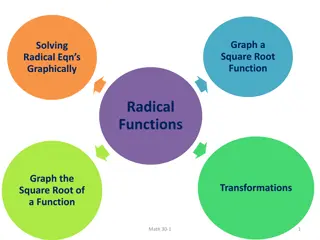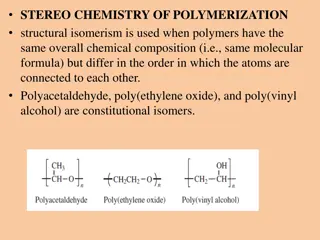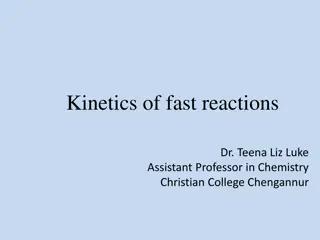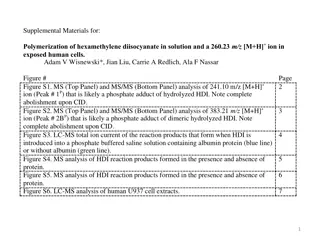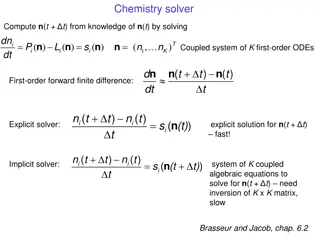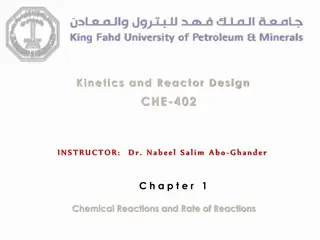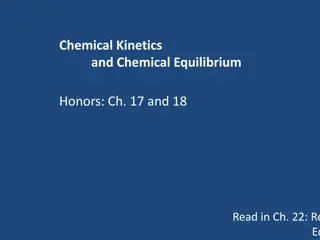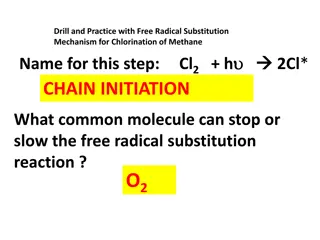Understanding Free Radical Polymerization Kinetics
This lecture covers the kinetics of free radical polymerization, including initiation, propagation, termination, and kinetic chain length concepts. It explains the calculation of kinetic chain length and chain-transfer reactions. Key points include the rate equations for initiation, propagation, and termination, as well as the steady-state assumption. The inverse relation between the kinetic chain length and radical concentration is highlighted.
Download Presentation

Please find below an Image/Link to download the presentation.
The content on the website is provided AS IS for your information and personal use only. It may not be sold, licensed, or shared on other websites without obtaining consent from the author. Download presentation by click this link. If you encounter any issues during the download, it is possible that the publisher has removed the file from their server.
E N D
Presentation Transcript
FREE-RADICAL POLYMERIZATION At the end of this lecture, you should be able to: - Understand the kinetic of free-radical polymerization. - Learn what is meant by kinetic-chain length. - Understand the calculation of kinetic-chain length. - Understand the chain-transfer reactions - Solving problems including chain-transfer reactions Mustansiriyah University/ Materials Eng. Dept. Dr Ahmed A. AYASH APRIL 2020 1
Kinetics of Free Radical Polymerization 1. Initiation kd I 2 R.Radical Generation ki R. + M M1.Initiation Assuming that ki >>kd and accounting for the fact that two Radicals are formed during every initiator decomposition, The rate of initiation, Ri is given by: Ri = d[Mi] = 2f kd [I] dt f = efficiency of the initiator and is usually 0.3< f >0.8. 2
2. Propagation kp M1. + M M2. kp M2. + M M3. kp M3. + M ... M4. kp Mx. + M Mx+1. Rp = - d[M] = kp[M .][M] dt 3
3. Termination kt Mx. + . My Mx-My (Combination) ktd Mx. + . My Mx + My (Disproportionation) Since two radicals are consumed in every termination, then: Rt = 2kt [M .]2 4. Steady-state Assumption Very early in the polymerization, the concentration of radicals becomes constant because Ri = Rt 2fkd[I] = 2kt [M .]2 4
2fkd [I] = 2kt [M .]2 Solve this equation for [M.]: [M.] = (fkd [I]/kt)1/2 Substituting the above equation into the propagation expression: Rp = kp[M.][M] = kp [M](fkd [I]/kt)1/2 Since the rate of propagation, Rp, is essentially the rate of polymerization, the rate of polymerization is proportional to [I]1/2 and [M]. 5
5. KINETIC CHAIN LENGTH The kinetic chain length, , is defined as the average number of monomers consumed by each primary radical. Obviously from this definition, the magnitude of the kinetic chain length will depend on the rate of the propagation relative to the termination rate, i.e.,: 1 At Steady State: 2 We know that : [M ] [M] 3 4 6
It follows on substitution for Rp and Rt in equation (2): 5 Substituting for [M ]from Equation(3) yields: [M ] [M] 6 Equations (5) and (6) are quite general and do not depend on the nature of initiation. Notice the inverse relation between the kinetic chain length and the radical concentration. For reactions initiated by the decomposition of an initiator, 7
Thus, Now, the number-average degree of polymerization can be calculated as follows:: Xn (or DPn) = 2Rp / Rt= 2 Rp/Ri for termination by combination Xn = Rp / Rt= Rp/Ri for termination by disproportionation So, Xn= 2 for termination by combination Xn = for termination by disproportionation NOTE: Xn is sometimes represented by Dp as we did in the previous lectures. 8
Example: For pure styrene polymerized at 60C, the value of the ratio kp2/kt is 0.0012 l/mol.s. The corresponding value for pure vinyl acetate polymerized at 60 C is 0.125 l/mol.s. a. Estimate their relative kinetic chain lengths. b. Calculate the kinetic chain length for polystyrene if the rate of polymerization is 10 4 mol/l.s and monomer concentration is 8.35 mol/l. Solution: Assume the rates of polymerization and monomer concentrations are the same for styrene(s), and vinyl acetate (VA). a) b) 9
HOMEWORK (2) Re-derive the rate of propagation for a free radical polymerization at steady-state condition as function of the initiator and monomer concentration Hint: you must get, Rp = kp [M](fkd [I]/kt)1/2 10





